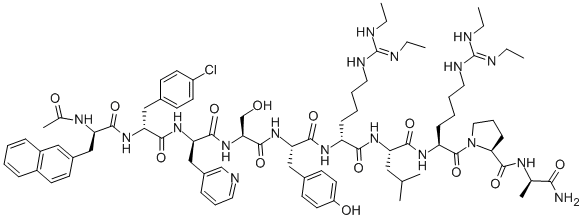Ganirelix Acetate
|
|
Ganirelix Acetate Eigenschaften
- Sequenz
- Ac-D-Nal-[D-(pCl)Phe]-D-Pal-Ser-Tyr-D-Har(Et2)-Leu-Har(Et2)-Pro-DAla-NH2
Sicherheit
| HS Code | 3504009000 |
|---|
Ganirelix Acetate Chemische Eigenschaften,Einsatz,Produktion Methoden
Originator
Antagon,OrganonTherapeutic Function
LHRH antagonistClinical Use
Ganirelix acetate is an analog of GnRH with substitutions at residues 1, 2, 3, 6, 8, and 10. It is not a superagonist but, rather, is a synthetic decapeptide with high antagonist activity and the first GnRH antagonist to be marketed. It is approved for the suppression of LH surges in women who are undergoing ovarian hyperstimulation fertility treatment; LH surges normally promote ovulation. The goal of this drug is to significantly reduce the number of medication days necessary to suppress the LH surge, thereby maintaining eggs in the ovaries. In vitro fertilization (IVF) treatment cycles were historically initiated by the administration of leuprolide acetate to suppress the premature release of LH. This inhibits ovulation so that the eggs remain available for retrieval by a fertility specialist. For this purpose, leuprolide acetate usually is injected for as many as 26 days. Clinical studies have shown that ganirelix acetate can shut down the LH surge in only 5 days of treatment, that the suppression of LH is more pronounced than that of FSH, and that the shorter treatment time minimizes unpleasant side effects, such as hot flashes and headaches.Ganirelix Acetate Upstream-Materialien And Downstream Produkte
Upstream-Materialien
Trifluoressigs?ure
N,N'-Methantetraylbis(1-methylethylamin)
Essigs?ureanhydrid
1-Hydroxybenzotriazol
Downstream Produkte
Ganirelix Acetate Anbieter Lieferant Produzent Hersteller Vertrieb H?ndler.
Global( 178)Lieferanten
| Firmenname | Telefon | Land | Produktkatalog | Edge Rate | |
|---|---|---|---|---|---|
| Hebei Chuanghai Biotechnology Co,.LTD | +86-13131129325 |
sales1@chuanghaibio.com | China | 5857 | 58 |
| Zibo Hangyu Biotechnology Development Co., Ltd | +86-0533-2185556 +8615965530500 |
nickzhang@hangyubiotech.com | China | 10983 | 58 |
| Shanghai Affida new material science and technology center | +undefined15081010295 |
admin@oudaxin.com | China | 114 | 58 |
| hebei hongtan Biotechnology Co., Ltd | +852-6619 3215 +86-17731935328 |
sales03@chemcn.cn | China | 970 | 58 |
| Shaanxi TNJONE Pharmaceutical Co., Ltd | +86-17396673057 |
linda@tnjone.com | China | 1143 | 58 |
| Adachibio Inc. | +81-8027837258 |
sales@adachi-bio.com | Japan | 992 | 58 |
| Henan Tianfu Chemical Co.,Ltd. | +86-0371-55170693 +86-19937530512 |
info@tianfuchem.com | China | 21628 | 55 |
| Shenzhen Nexconn Pharmatechs Ltd | +86-755-89396905 +86-15013857715 |
admin@nexconn.com | China | 10406 | 58 |
| BOC Sciences | +1-631-485-4226 |
inquiry@bocsci.com | United States | 19552 | 58 |
| Shanghai Longyu Biotechnology Co., Ltd. | +8619521488211 |
info@longyupharma.com | China | 2556 | 58 |
123246-29-7()Verwandte Suche:
- Ac-DNal-DCpa-DPal-Ser-Tyr-DHar(Et2)-Leu-Har(Et2)-Pro-DAla -NH2
- ganirelix Acetate
- GANIRELIX
- Ganirelixum
- Ganirelix Acetate USP/EP/BP
- Ganirelix Impurity 1
- Ganirelix Acetate API
- 3-?bis[[3-?(3
- 4-?dihydroxyphenyl)?-?1-?oxo-?2-?propen-?1-?yl]?oxy]?-?4
- 5-?dihydroxy-
- Ganirelix DiAcetate
- 123246-29-7
- 23246-29-7
- C80H113ClN18O13
- hormones







